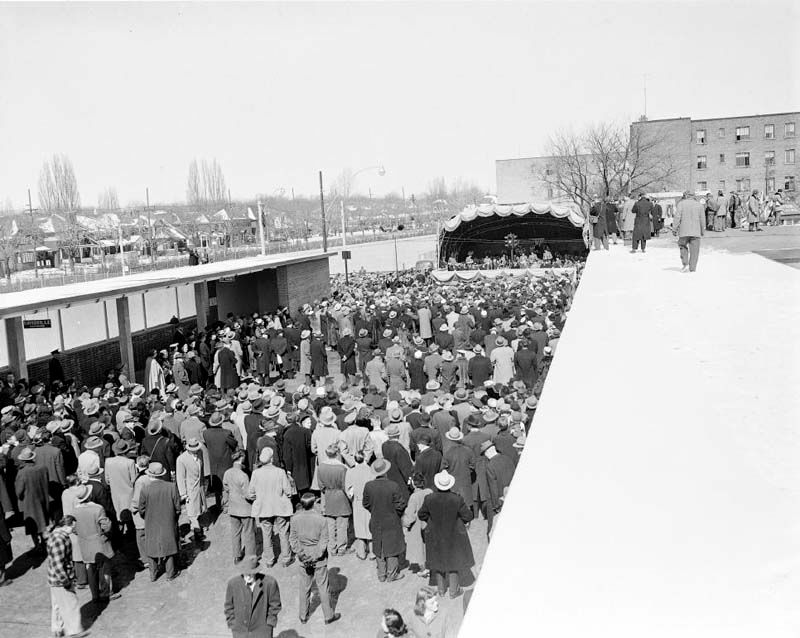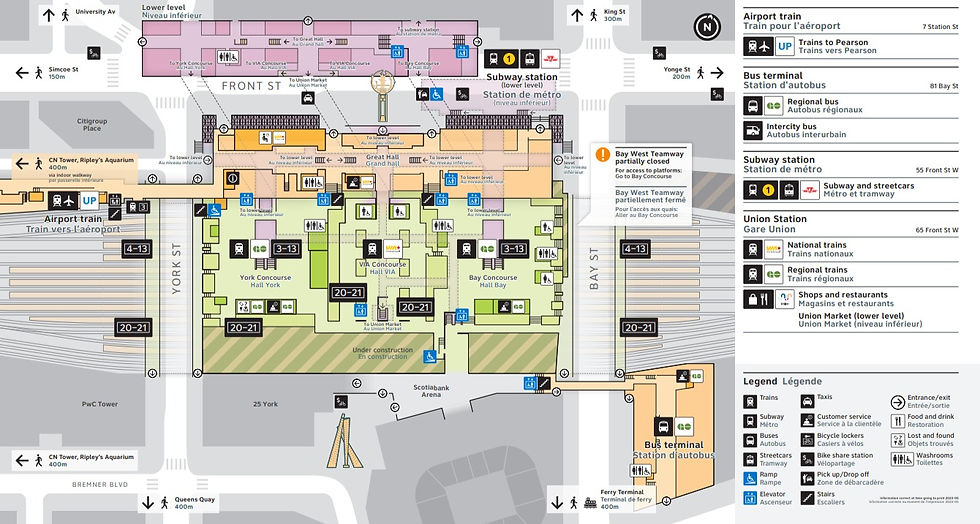Accessibility and Accommodation in the TTC System
- shazarakhan1035
- Oct 13, 2023
- 4 min read
Updated: Oct 29, 2023

Union Station is the largest and most central station within the Toronto Transit Commission (TTC) system. Source: Shazara Khan
The TTC's Origins
The Toronto Transit Commission, or TTC, is the agency that runs the Greater Toronto Area's public transport system. Established in 1954 to replace theToronto Transportation Commission, it launched Canada's first subway system to accomodate the city's growing population. The new line boasted speed and convenience that made it worthy of replacing the street cars on Yonge Street.
Thousands crowded Davisville Station on 30 March, 1954 as the subway system was inaugurated. And more than 206,000 people rode the train on opening day.
Shortly after the Yonge Line opened, the TTC started to plan its expansion. They extended the line along University Avenue in 1963 to make it easier for workers travelling downtown.
Three years later, they opened the Bloor-Danforth line to offer more connections to downtown.
In the 1970s, the TTC further expanded the two lines to include stations between Kennedy and Kipling. And in 1985, they opened the Scarborough Rapid Transit System to accomodate commuters from Toronto's east end.
Years passed without changes until 2002, when the TTC introduced a new line connecting Sheppard Avenue East to Don Mills.
They have also operated streetcars and buses since 1861 and 1921, respectively.

A large crowd gathers at Davisville Station to watch the the opening ceremony for Canada's first subway line. Source: Toronto City Archives
What is Accessbility?
Accessibility is the practice of making sure that everyone's needs are accommodated. Examples in everyday life include ramps for wheelchair users and closed captions for people with visual impairments.
Many people rely on public transport to get them where they need to be, but not everyone has the same needs when travelling. Some passengers have disabilities that make it harder for them to use specific services.
Public transport stations now include a variety of services, including elevators, ramps and braille text.
Are TTC Stations Really Accessible?
As the largest metropolitan area in Canada, Toronto boasts a population of over 6.4 million people.
Its transit system is also the largest in Canada, with 184 bus routes, 75 subway stations and 294 connections between them. Only 55 of these stations are currently accessible, but the TTC plans to increase this to all stations by 2025.
Union Station is Canada's largest subway station and the TTC's central hub. It was first opened in 1927 as a way to combine the Canadian Pacific Railway and Grand Trunk Railway into the Canadian National Railway. The current structure replaced a previous version which was demolished in 1931.
As of 2023, the station has 3 levels with more 100 stores. It also offers connections to the national Via Rail and provincial GO Transit lines.

A cross section of Union Station shows all platforms and amenities. Source: Metrolinx
The station has 27 elevators and four accessible ramps. It also has escalators for people who have difficulty walking.
But Union Station may still have some problems with accessibility.
Commuters with disabilities have to walk through long corridors without elevators or ramps in sight. In the station's first and third levels, there is little to no signage directing people towards elevators.
The TTC's poor signage is another accessibility issue.
While Union Station has more amenities than any other station in the city, its signs are hardly indicitave of this. In addition to offering vague directions, the small text can make it harder for visually impaired commuters to navigate through the station.
A Scarborough resident, who asked to remain anonymous, spoke about her issues with arthritis and how it is difficult for her to navigate through large TTC stations like Union.
"I have severe knee pain, so it's hard for me to walk up the stairs," she said. "Even if there are elevators, the signs are so bad that I have to use stairs when I go out [to the street]."
She compared the TTC's signs to those of the London Underground in the UK, saying the latter was "much better."
The TTC Can Do A Better Job of Accomodating Riders
Despite being in service for almost 70 years, the TTC system needs to properly accomodate travellers from Toronto's east end.
Commuters from Scarborough can no longer use the permanently derailed Line 3 to travel downtown. Instead, they have to take an express bus route from Scarborough Centre to Kennedy Station.
The TTC also reports frequent disruptions with their services, ranging from route changes for buses and streetcars to closures for subway lines.
This unpredictability can discourage some commuters from relying on the system for public transport.
Heidi, a Pickering resident and university student, said she prefers the GO Transit system because it is a more reliable way to travel.
"The GO Train is more convenient," said Heidi. "When I went to the Toronto FC game, they [the TTC] shut down two stops before Union and we had to take a shuttle there."
Being fully accessible means making those services visible for people who need them. By improving their signage and increasing their accomodations , the TTC can work towards making public transport better for all residents of the Greater Toronto Area.
Link for Donations
Help support non-biased and honest journalists like Shazara. She is dedicated to sharing honest and trustworthy news with you all. Help support her journalistic efforts by donating to the link below: https://square.link/u/vxunYDxq








Comments